
Berthe Marie Pauline Morisot was a French painter and a member of the circle of painters in Paris who became known as the Impressionists.

Impressionism was a 19th-century art movement characterized by relatively small, thin, yet visible brush strokes, open composition, emphasis on accurate depiction of light in its changing qualities, ordinary subject matter, unusual visual angles, and inclusion of movement as a crucial element of human perception and experience. Impressionism originated with a group of Paris-based artists whose independent exhibitions brought them to prominence during the 1870s and 1880s.

Mary Stevenson Cassatt was an American painter and printmaker. She was born in Allegheny, Pennsylvania, and lived much of her adult life in France, where she befriended Edgar Degas and exhibited with the Impressionists. Cassatt often created images of the social and private lives of women, with particular emphasis on the intimate bonds between mothers and children.

Edgar Degas was a French Impressionist artist famous for his pastel drawings and oil paintings.

The Little Fourteen-Year-Old Dancer is a sculpture begun c. 1880 by Edgar Degas of a young student of the Paris Opera Ballet dance school, a Belgian named Marie van Goethem.
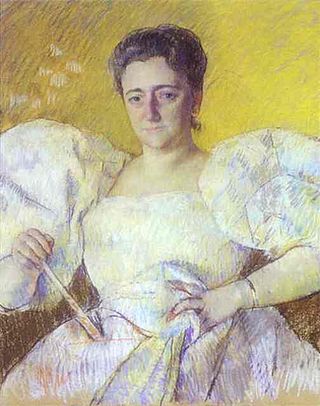
Louisine Waldron Elder Havemeyer was an art collector, feminist, and philanthropist. In addition to being a patron of impressionist art, she was one of the more prominent contributors to the suffrage movement in the United States. The impressionist painter Edgar Degas and feminist Alice Paul were among the renowned recipients of this benefactor's support.

The Child's Bath is an 1893 oil painting by American artist Mary Cassatt. The painting continues her interest in depicting bathing and motherhood, but it is distinct in its angle of vision. Both the subject matter and the overhead perspective were inspired by Japanese Woodcut prints and Edgar Degas.

Miss La La at the Cirque Fernando is an oil on canvas painting by the French Impressionist artist Edgar Degas. Painted in 1879 and exhibited at the Fourth Impressionist Exhibition in Paris that same year, it is now in the collection of the National Gallery in London. It is Degas's only circus painting, and Miss La La is the only identifiable person of color in Degas's works. The special identity of Miss La La and the great skills Degas used in painting her performance in the circus made this piece of art important, widely appreciated but, at the same time, controversial.
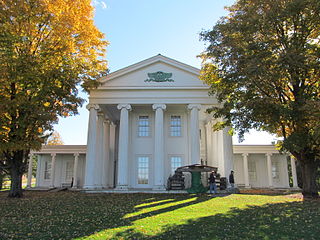
The Electra Havemeyer Webb Memorial Building is an exhibit building located at the Shelburne Museum in Shelburne, in the U.S. state of Vermont. It was built as a memorial to the museum's founder, Electra Havemeyer Webb, and her husband, James Watson Webb II. It is home to the museum's European Paintings Collection. The collection is shown in six period rooms relocated from Electra and J. Watson Webb's 1930s New York City apartment at 740 Park Avenue.

Young Woman in Blue is a drawing by French artist Edgar Degas, created in 1884. It is currently in the permanent collection at the Indianapolis Museum of Art.

Little Girl in a Blue Armchair is an 1878 oil painting by the American painter, printmaker, pastelist, and connoisseur Mary Cassatt. It is in the collection of the National Gallery of Art, Washington D.C. Edgar Degas made some changes in the painting.

Gardner (Cassatt) Held by His Mother is a drypoint print dated circa 1889 by the American painter, printmaker, pastelist, and connoisseur Mary Cassatt. The example illustrated is in the collection of the Cooper-Hewitt Museum and is a gift of Samuel Putnam Avery.

After the Bath, Woman Drying Herself is a pastel drawing by Edgar Degas, made between 1890 and 1895. Since 1959, it has been in the collection of the National Gallery, London. This work is one in a series of pastels and oils that Degas created depicting female nudes. Originally, Degas exhibited his works at Impressionist exhibitions in Paris, where he gained a loyal following.
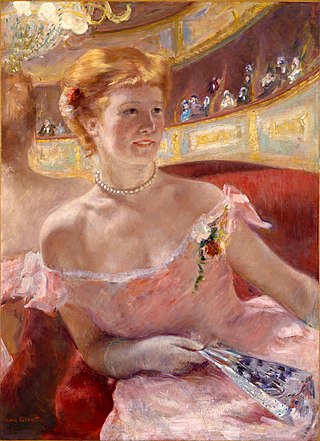
Woman with a Pearl Necklace in a Loge is an 1879 painting by American artist Mary Cassatt. The Philadelphia Museum of Art acquired the painting in 1978 from the bequest of Charlotte Dorrance Wright. The style in which it was painted and the depiction of shifting light and color was influenced by Impressionism. This painting shows a view of the modern woman and is similar in style to Degas.

The Boating Party is an oil painting by American artist Mary Cassatt created in 1893. It is also known under the titles La partie en bateau; La barque; Les canotiers; and En canot. Measuring nearly three by four feet, it is Cassatt’s largest and most ambitious painting. It has been in the Chester Dale Collection of the National Gallery of Art since 1963.

Young Mother Sewing aka Little Girl Leaning on her Mother's Knee is a 1900 painting by Mary Cassatt. It is in the collection of the Metropolitan Museum of Art.

Mother and Child (The Oval Mirror) is an oil-on-canvas painting by Mary Cassatt. The painting depicts a mother and her child in front of a mirror. The painting provides a glimpse of the domestic life of a mother and her child, evoking religious iconography from the Italian Renaissance. However, portrayals of a mother and her child are common in Cassatt's work, so it is possible that this similarity is coincidental rather than intentional.
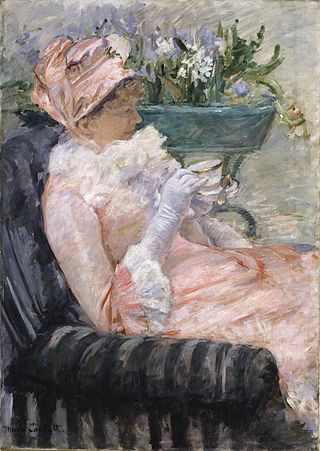
The American artist Mary Cassatt painted The Cup of Tea in Paris ca. 1879–1881. The painting depicts Mary's sister Lydia Cassatt in a typical, upper class-Parisian ritual of afternoon tea. Scholars have observed that Cassatt's choice to employ vivid colors, loose brushstrokes, and unique perspective to portray the scene makes it a quintessentially Impressionist painting.
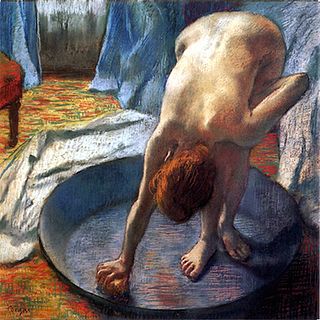
Woman in a Tub is one of a suite of pastels on paper created by the French painter Edgar Degas in the 1880s and is in the collection of the Hill-Stead Museum in Connecticut. The suite of pastels all featured nude women "bathing, washing, drying, wiping themselves, combing their hair or having it combed" and were created in readiness for the sixth and final Impressionist Exhibition of 1886.

A Woman and a Girl Driving is an oil-on-canvas painting by American Impressionist Mary Cassatt, painted in 1881. It emphasizes the theme of female autonomy in a male dominated society. Lydia Cassatt, the artist's sister, is shown holding the reins of the family's carriage alongside Odile Fèvre, the niece of Edgar Degas, and a servant to the family, Mathieu, traveling through the Bois de Boulogne in Paris. Emphasizing Lydia's position of command, Cassatt draws attention to the evolving perceptions of female identity in the late 19th century. The painting serves to challenge prevailing social norms of the time and unveil the range of female experience.





















